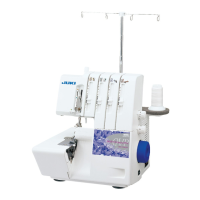Trial sewing, Thread tension
Thread tension
Thread tension should be adjusted to suit the various types of work.
The ideal thread tension for most fabrics and threads is between 3 and 5.
However this can vary quite considerably when special threads such
as filament, woolly nylon, buttonhole twist (cordonet), pearl yarn or
decorative threads are used. Infinitely variable adjustments can be
made from 1-9. Move the lever upwards for more tension, move the le-
ver downwards for less tension.
A
B
C
D
E
F
Adjusting the thread tension
Lower or raise the tension levers by only half or one number, then test
sew again and check the result.
• The loops are formed on the underside:
Tighten the upper looper thread tension, (blue) or loosen the lower
looper thread tension, red (A).
• The loops are formed on the upper- side:
Tighten the lower looper thread tension, (red) or loosen the upper
looper thread tension, blue (B).
• The right- hand needle thread forms loops on the underside:
Tighten the right- hand needle thread tension, green (C).
• The left- hand needle forms loops on the underside:
Tighten the left- hand needle thread tension, yellow (D).
• The edge of the fabric curls up, tension for both looper threads is too
tight:
Loosen upper and lower looper thread tension, blue and red (E).
• The fabric puckers during sewing:
Loosen the right- or left-hand needle thread tension, green or yellow
(F).
18

